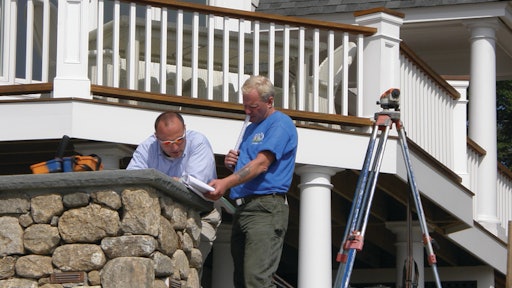
Salespeople who consistently outperform their rivals follow a sales process. Do you have a sales process in place? Many contractors think they do, but it’s often ineffective, misunderstood by employees, and/or inconsistently followed.
An effective sales process follows five basic steps:
- Generate lead
- First appointment
- Prepare proposal
- Validate the relationship
- Life after the sale
The great thing about the fifth step is that, when executed effectively, it starts the process of generating new leads via additional services and landscape upgrades, not to mention referrals. That’s right: By following this five-step sales process, you can continuously feed your sales engine with new leads.
In order to get your sales process put in place, start by asking yourself the following questions.
Would you and/or your team be able to give a consistent elevator pitch? That’s a short summary used to quickly and simply define a product, service or company—and the value a consumer can expect to receive when doing business with you. If not, collaborate with your team to get something on paper, refine it, and read it over and over again until it becomes ingrained in your minds.
Can you describe with confidence how your company will manage the next lead you receive? There is nothing more frustrating than taking a phone call or grabbing a business card, and then you can’t find it three weeks later. It’s important to have a sales process that starts as soon as you put your hands on a new lead.
Do my salespeople know the goals of a successful first appointment with a prospect? You can almost liken this to playing chess: You know what you want the end result to be; it’s getting to that point that can be a challenge. You certainly want to arrive on time, look professional, and know the names of the people you’re meeting with. You want to exude confidence and instill confidence in your potential client.
But what else? Do you simply want to get into the nitty gritty of the proposal or estimate? Do you want to convey your company story? Do you want to learn more about the client so you can establish more of a personal connection? Do you want to share more personal information about yourself? These are things you and your team should agree upon, and then make it part of the process that everyone follows consistently.
Is there a defined set of tools to use in that first appointment to set your company apart from the competition? There are some basic items you should bring to that first appointment, including a brief history of your company and list of your credentials, client testimonials, and before and after pictures, to name a few.
Some successful organizations create information trees, which help salespeople figure out how to react when a customer answers a question a certain way. It’s scripted so well that it gives the salesperson a solid game plan. It removes confusion, creates preparedness, and ultimately helps salespeople build confidence and close more sales.
Have you reviewed and/or revised your proposal package in the past year? Things aren’t what they used to be. It’s more competitive, and it’s more difficult to close sales. Does your proposal package tell the prospect everything he or she needs to know? Does it bore them with things they don’t care about? Does it help you stand out from your competitors?
Could a 12-year-old put a proposal together for you? You want this process to be simple and straightforward, in template-type fashion. When your people clearly understand what is and is not to be included in your proposal package, both efficiency and consistency spikes.
Do you know your closing ratio? There’s nothing like the exhilaration one feels after closing a sale. And there’s nothing like scorekeeping to help improve a company’s sales closing ratio. How many jobs did you bid on? How many jobs were you awarded? Figure out the percentage and challenge your team to start raising that bar. Something as simple as checkmarks on a chalkboard is all you need. Awareness is what it’s all about.
Do you role play? Role playing is a very effective form of sales training. Practice asking for the sale, overcoming objections, etc. Just like anything else, selling takes practice, practice, practice.
Does your sales process continue into life after the sale? Do you intentionally go after additional business and/or referrals from your existing clients? This is the most cost-effective way to grow a landscaping business. Staying in touch with existing clients, asking them for testimonials and/or referrals, must be part of your sales process. If you’re not doing this, identify some simple things you can do immediately to get started, such as calling five existing clients a week just to say you were thinking of them and wanted to see how they were doing.





























